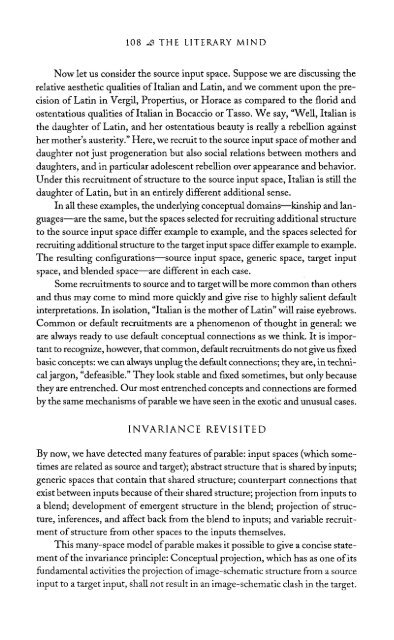The Literary Mind.pdf
The Literary Mind.pdf
The Literary Mind.pdf
Create successful ePaper yourself
Turn your PDF publications into a flip-book with our unique Google optimized e-Paper software.
108 THE LITERARY MIND<br />
Now let us consider the source input space. Suppose we are discussing the<br />
relative aesthetic qualities of Italian and Latin, and we comment upon the precision<br />
of Latin in Vergil, Propertius, or Horace as compared to the florid and<br />
ostentatious qualities of Italian in Bocaccio or Tasso. We say, "Well, Italian is<br />
the daughter of Latin, and her ostentatious beauty is really a rebellion against<br />
her mother's austerity." Here, we recruit to the source input space of mother and<br />
daughter not just progeneration but also social relations between mothers and<br />
daughters, and in particular adolescent rebellion over appearance and behavior.<br />
Under this recruitment of structure to the source input space, Italian is still the<br />
daughter of Latin, but in an entirely different additional sense.<br />
In all these examples, the underlying conceptual domains—kinship and languages—are<br />
the same, but the spaces selected for recruiting additional structure<br />
to the source input space differ example to example, and the spaces selected for<br />
recruiting additional structure to the target input space differ example to example.<br />
<strong>The</strong> resulting configurations—source input space, generic space, target input<br />
space, and blended space—are different in each case.<br />
Some recruitments to source and to target will be more common than others<br />
and thus may come to mind more quickly and give rise to highly salient default<br />
interpretations. In isolation, "Italian is the mother of Latin" will raise eyebrows.<br />
Common or default recruitments are a phenomenon of thought in general: we<br />
are always ready to use default conceptual connections as we think. It is important<br />
to recognize, however, that common, default recruitments do not give us fixed<br />
basic concepts: we can always unplug the default connections; they are, in technical<br />
jargon, "defeasible." <strong>The</strong>y look stable and fixed sometimes, but only because<br />
they are entrenched. Our most entrenched concepts and connections are formed<br />
by the same mechanisms of parable we have seen in the exotic and unusual cases.<br />
INVARIANCE REVISITED<br />
By now, we have detected many features of parable: input spaces (which sometimes<br />
are related as source and target); abstract structure that is shared by inputs;<br />
generic spaces that contain that shared structure; counterpart connections that<br />
exist between inputs because of their shared structure; projection from inputs to<br />
a blend; development of emergent structure in the blend; projection of structure,<br />
inferences, and affect back from the blend to inputs; and variable recruitment<br />
of structure from other spaces to the inputs themselves.<br />
This many-space model of parable makes it possible to give a concise statement<br />
of the invariance principle: Conceptual projection, which has as one of its<br />
fundamental activities the projection of image-schematic structure from a source<br />
input to a target input, shall not result in an image-schematic clash in the target.















